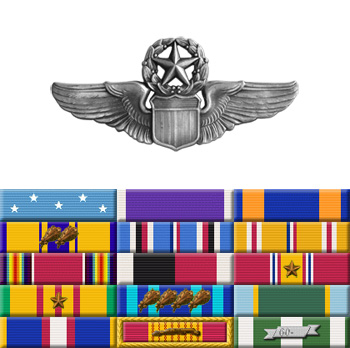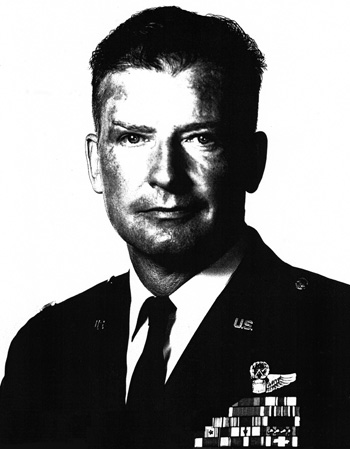William Jones was born on May 31, 1922, in Norfolk, Virginia. He graduated with a Bachelor's degree from the University of Virginia before entering the U.S. Military Academy in July 1942. He graduated from West Point and received a commission as a 2Lt in the U.S. Army Air Forces on July 4, 1945. Jones completed pilot training while at the Academy and he transitioned into B-25 Mitchell and B-24 Liberator bombers shortly after graduation. He served as a bomber, night fighter, rescue, and transport pilot during the late 1940's. Jones served at Biggs AFB, Texas, from February 1948 to December 1952, and he flew in Europe with USAFE from December 1952 to August 1956. Jones next completed transition training in the B-47 Stratojet bomber and served at Lake Charles AFB, Louisiana (changed to Chennault AFB in 1958), from July 1957 to October 1959. He served as an engineering officer and B-47 Aircraft Commander at Pease AFB, New Hampshire, from October 1959 to August 1965, and then went through the Air War College at Maxwell AFB, Alabama, from August 1965 to July 1966. His next assignment was at USAF Headquarters at the Pentagon, from July 1966 until he went through combat crew training in the A-1 Skyraider in March 1968. Jones next became commanding officer of the 602nd Special Operations Squadron at Udorn and then Nakhon Phanom Royal Thai AFB, Thailand, in April 1968. On September 1, 1968, Col Jones was badly injured during a combat mission for which he would later be awarded the Medal of Honor. After hospitalization for his injuries, he was assigned as commander of the 1st Flying Training Squadron at Andrews AFB, Maryland. Col Jones was killed during a flight in his private plane on November 15, 1969. He was posthumously awarded the Medal of Honor on August 6, 1970.
His Medal of Honor Citation reads:
The President of the United States of America, authorized by Act of Congress, March 3, 1863, has awarded in the name of The Congress, the Medal of Honor to LIEUTENANT COLONEL WILLIAM A. JONES, III UNITED STATES AIR FORCE for conspicuous gallantry and intrepidity in action at the risk of his life above and beyond the call of duty: On 1 September 1968, Colonel Jones distinguished himself as the pilot of an A-1H Skyraider aircraft near Dong Hoi, North Vietnam. On that date, as the on-scene commander in the attempted rescue of a downed United States pilot, Colonel Jones' aircraft was repeatedly hit by heavy and accurate antiaircraft fire. On one of his low passes, Colonel Jones felt an explosion beneath his aircraft and his cockpit rapidly filled with smoke. With complete disregard of the possibility that his aircraft might still be burning, he unhesitatingly continued his search for the downed pilot. On this pass, he sighted the survivor and a multiple-barrel gun position firing at him from near the top of a karst formation. He could not attack the gun position on that pass for fear he would endanger the downed pilot. Leaving himself exposed to the gun position, Colonel Jones attacked the position with cannon and rocket fire on two successive passes. On his second pass, the aircraft was hit with multiple rounds of automatic weapons fire. One round impacted the Yankee Extraction System rocket mounted directly behind his headrest, igniting the rocket. His aircraft was observed to burst into flames in the center fuselage section, with flames engulfing the cockpit area. He pulled the extraction handle, jettisoning the canopy. The influx of fresh air made the fire burn with greater intensity for a few moments, but since the rocket motor had already burned, the extraction system did not pull Colonel Jones from the aircraft. Despite searing pains from severe burns sustained on his arms, hands, neck, shoulders, and face, Colonel Jones pulled his aircraft into a climb and attempted to transmit the location of the downed pilot and the enemy gun position to the other aircraft in the area. His calls were blocked by other aircraft transmissions repeatedly directing him to bail out and within seconds his transmitters were disabled and he could receive only on one channel. Completely disregarding his injuries, he elected to fly his crippled aircraft back to his base and pass on essential information for the rescue rather than bail out. Colonel Jones successfully landed his heavily damaged aircraft and passed the information to a debriefing officer while on the operating table. As a result of his heroic actions and complete disregard for his personal safety, the downed pilot was rescued later in the day. Colonel Jones' conspicuous gallantry, his profound concern for his fellowman, and his intrepidity at the risk of his life, above and beyond the call of duty, are in keeping with the highest traditions of the United States Air Force and reflect great credit upon himself and the Armed Forces of his country.
|



